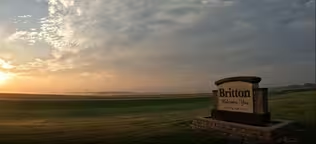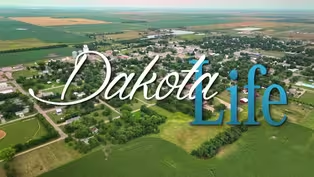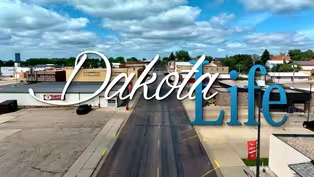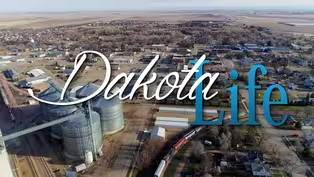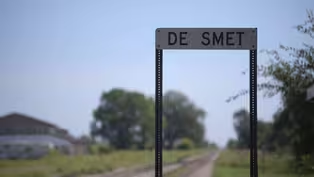Dakota Life
Greetings from Milbank
Season 24 Episode 2 | 26m 58sVideo has Closed Captions
Milbank is a vibrant community on the eastern edge of South Dakota’s glacial lakes
Built by English settler Henry Holland, the Milbank Grist Mill was reconstructed in 2009. Misener of Stockholm has been collecting keyed instruments for nearly 40 years. Milbank is the birthplace of American Legion baseball in the US, and Mike Mach of Milbank recently won a National Senior Bowling Championship. Amy Thue and Sara Snaza own a boutique and are helping to revitalize the downtown.
Problems playing video? | Closed Captioning Feedback
Problems playing video? | Closed Captioning Feedback
Dakota Life is a local public television program presented by SDPB
Support Dakota Life with a gift to the Friends of Public Broadcasting
Dakota Life
Greetings from Milbank
Season 24 Episode 2 | 26m 58sVideo has Closed Captions
Built by English settler Henry Holland, the Milbank Grist Mill was reconstructed in 2009. Misener of Stockholm has been collecting keyed instruments for nearly 40 years. Milbank is the birthplace of American Legion baseball in the US, and Mike Mach of Milbank recently won a National Senior Bowling Championship. Amy Thue and Sara Snaza own a boutique and are helping to revitalize the downtown.
Problems playing video? | Closed Captioning Feedback
How to Watch Dakota Life
Dakota Life is available to stream on pbs.org and the free PBS App, available on iPhone, Apple TV, Android TV, Android smartphones, Amazon Fire TV, Amazon Fire Tablet, Roku, Samsung Smart TV, and Vizio.
Providing Support for PBS.org
Learn Moreabout PBS online sponsorshipMore from This Collection
Dakota Life stories from towns in northeast South Dakota
Video has Closed Captions
Visit Britton and learn about people who do good in this Marshall County town. (29m 45s)
Video has Closed Captions
Travel with us to Desmet, Arlington, Viborg, the Black Hills and Clear Lake. (28m 15s)
Providing Support for PBS.org
Learn Moreabout PBS online sponsorship(upbeat music) - This is a production of South Dakota, Public Broadcasting.
- Milbank is a small but vibrant community on the Eastern edge of south Dakota's Glacial Lakes country.
The village of Milbank junction was founded in 1880 when the Chicago, Milwaukee and Saint Paul railroad known as the Milwaukee road first laid track in Dakota territory.
The town was named after railroad executive, Jeremiah Milbank.
It's located on the South Fork of the Whetstone River, and Mil bank is surrounded by Rolling Prairie and ancient glacial lakes.
Welcome to Dakota life and greetings from Mil bank.
(upbeat piano music) - This program is made possible by members like you with corporate support from valley Queen cheese in Milbank and by Dakota Granite, the granite people.
- The Milwaukee road, and the Dakota territory bureau of immigration played an integral role in enticing immigrants to homestead in grant county.
They sent agents to German and Scandinavian ports with offers of reduced ship fares and reports of fertile farmlands.
Early European migrants rode home describing chest high grasses on the native tall grass Prairie Coteau and not a tree in sight.
Sod was the most readily available building material.
Milbank grew quick at first, but was stopped in its tracks by the infamous blizzards of 1880 and 81.
It snowed in the railroads for three months but later that year Milbank beat out Big Stone City to be named County Seat for Grand County.
And now that we visit 140 years later, we're going to talk with a pair of sisters who are co-owners of Whimsy on Main.
We're going to talk about the bustling women owned downtown business scene.
We'll meet a local bowler who originally fulfilled a lifelong dream.
we'll visit a local piano tuner with a nap for putting the Grande back in the grand piano.
And did you know American Legion baseball started right here in Mil bank.
So stay with us.
But our first stop is a tour of Millbanks, iconic Hollands Grist Mill built by Henry Hollands in 1885 and painstakingly reconstructed between 1997 and 2009.
(footsteps) (machine whistling) (machine rolling) (machine running) - I was thinking, you know, it's been 15 years ago, but it's been longer than that.
- Its been, - Wow - It's been 21 years ago because I remember 9, 11 we were up here working, - Working - On it.
And that's when George came and told us what was happening, - what was going on?
- Yeah.
- Well, Henry Hollands is the man that created the Hollis Mill in Milbank.
He was born in 1841.
He was born in England and he emigrated to the U.S specifically to Chicago in 1870.
So he was 29 years old when he came, he came with a skull of baker.
So he understood baking bakery.
He understood flour, presumably understood mill.
He must've understood the milling.
- He could mark each one where it went and that's what you followed him.
- Okay.
- We think Henry Hollis built to original mill around 1882 to 1884.
There were some articles in different papers saying that it was open for business.
Grinding the finest flour in the area, Henry operated the meal for probably half dozen years and sold half interest in the mill to other people.
- The competition must've started to force the issue a little bit - Through the newspaper articles it looks like the last time the mill had run was approximately 1909.
- So it just sort of sat there.
- It sat idle for a hundred years before we grown green again for the first time in 2009.
- It was used as a visitor center until it got to the point it wasn't safe because things were rotting.
So then they had to close it.
Short story of it rather than to repair it.
We decided to completely rebuild it from scratch.
There were no blueprints to follow.
So we strictly had to follow the old structure, especially all the gear things in the makings of everything up on top.
- Anytime the wind switches directions it'll hit the fan tail and turn the cap of the whole windmill into the wind again.
So the sales are always pointed into the wind catch the maximum power.
- There were people questioning why you would want to spend that kind of money for something, you know, but it's history.
- You have to have the motivation.
You have to see the importance of it.
Not everybody does, you know, a lot of people in small towns, they're so busy trying to make a living and just surviving They don't really care a lot about that, so it takes a few people usually to have the insights you know, that maybe there's more to this that maybe we can do more with it.
We can use it in some manner or another that helps all of us.
- it's just a interesting part of Milbank that needed to be preserved.
And we need to keep it going.
(Scottish music) - The wind is essential to the mill, but it can sure challenge a ballplayer, trying to catch a pop fly out in center field.
Let's travel back to 1919 it's post-World War I The American Legion was just founded to advocate for veterans issues.
The legions membership roles grew rapidly and they achieved results.
The Legion was instrumental in establishment of the U.S veterans bureau.
We know it now is the Veterans Administration or the VA.
Here in Grand County veterans were quick to establish a local American Legion post it's Birch Miller Post Nine named after Ernest T Birch, the first grant county casualty of world war I and Charles R. Miller who lost his life in 1943, fighting in North Africa during world war II.
The Legion held at state convention in South Dakota in 1925 here in Milbank.
And at that meeting, the members pledged to launch a summer baseball program for teens.
We know it now as American Legion Baseball, the first tournaments were held the following year.
Today, Legion baseball is nationwide with over 80,000 youngsters playing every year.
And though it's been nearly a century since Legion baseball was born here.
Milbank still roots for the home team at the old ballgame.
- That is, it's really neat.
There's only one community in the country that gets to wear that title.
And fortunately it's Milbank, you know, the history is long and it's really special to see our core baseball group is very strong in promoting baseball but at the same time it also draws in that what I would say, the casual observers, just because of what it is.
So it's a good deal.
(Slow violin music) Date Legion convention in 1925 was held in Milbank.
And one of the guys recruited a gentleman, I believe it was a general, retired general to come and speak.
And as part of his speech he challenged, the Legion members to do something for the youth of the country and made the suggestion of baseball.
And that's where that's what got everything ticking.
And they passed a resolution at that meeting that, the Legion should start a baseball program.
That's what got the ball rolling was one gentleman's urging to the Legion members to do something for the youth.
And we sit today.
I'm sure that none of them had the foresight that it was going to.
I mean, he was probably thinking you should do that in Milbank and Water town and Sioux Falls.
and to see it grow into what it has become, I'm sure that they didn't expect that, but it's really neat that it has that it's and it's really neat that over 95 years that the Legion guys have carried that torch.
- I think the reason that it is so, so valuable here is we have a statue over here just on your side of the highway that predicts the mix of when it started and people see that and I, you know, Its it made out of granite its really an eye catcher it has been there for many, many years.
As you can see our trophi case some of the old people that played, they are the ones that started it.
And I think that generations, as we get older, you know, I guess that's probably one of the reasons I'm still coaching is that I have so many values of American Legion baseball that I think need to be carried throughout the generations with the code that has spoken at before each game.
Its keeping the rules and keeping faith with teammates keeping your temper, all the things that go into that part of it is, is brought out before each game that is played and no matter what state in the union it is, its said before each game.
And it's really a traditional thing that the American Legion has done and has really adhered to in everything that they've done throughout the, the many, many years it has been in existence.
- It's funny because I think the culture and the country has changed so much since 1925, when they came up with the idea of giving something for the youth to do.
there's so much more to do for children these days.
and baseball's one of those games that it might be a little slower moving than most it's a little harder to do than most.
So it takes a special kind of person but we're still 250 plus strong and Milbank the youth that are playing and you see a lot of comunities around the state they'll have a team this year.
They won't have next year and we battled pretty good.
Our numbers have stayed well and good.
And we've been able to feel teams and basically the competitive teams throughout the time.
- Now, from the ballpark to the business district, the architecture and Millbanks downtown is resident of a Prairie Town with tall expectations.
The two story first national bank building built in 1900, really wouldn't look out of place in a town of 30 or 300,000 and Millbanks 3000 plus residents are proud of the town's historic center and it shows elegant brick storefronts welcome shoppers.
As they did one passenger trains made stops at Mil bank Junction.
The first national bank building is now the home of the Grand County Review the weekly newspaper across main street in another historic brick building with colorful murals on the second story windows, sisters Amy Thue and Sara Snaza owned whimsy on Maine, a boutique and independent bookstore.
The two are part of a growing community of Mil bank based women, business owners.
And they have a whimsical take on how to make a go for it on Main Street.
- I can't imagine raising my kids any place else.
It, the memories and now for them to experience.
I have a daughter that just moved back with her one year old and she said she would never live in Mil bank.
And now that she's here too, I don't know that she'll ever leave either.
It's just it's home.
- Sarah and Amy grew up in Mil bank, lived elsewhere, but moved back home to raise their families.
They're also part of a community investment in downtown.
It started three years ago with improvements to streets, sidewalks, and other infrastructure and it continues.
- We're still working on pushing to get like plants on the new light posts and benches and some of those kinds of things.
Its working progress.
- But we have seen similar businesses - True - Come to town - The buildings are empty.
- yeah right now I think we're probably down to having one empty building on Main Street.
- Individual downtown storefronts have updated their look, but when you go inside you learn something very special about downtown Milbank.
- Main Street is very women driven, owned in Milbank, which is really amazing to see.
And it is a story.
And, you know, I think we can all look to, I mean, like Linda and Kay are - not the flower shop.
- Are not the flower shop they've both been around for a number of years and we can look at that growing up here.
And they were there when, we were younger and they can do it and they've got great businesses.
So we want to add to that.
And it's really fun to to see that.
And especially I have three girls.
So for them to see that this is really, you know, - it's possible, it's possible and to be able to have those conversations.
And we're just to that point where we're getting some high school girls that are gonna start working for us and to be able to share that with them and for them to see what we do.
And you know, a lot of kids don't learn, oh, I want to be an entrepreneur.
You know, its I want to be a nurse.
I want to be a teacher, but it'll be fun to start to share that a little bit more.
- Downtown business owners support each other, but they look beyond the brick and mortar.
Amy and Sarah have been very active marketing, Whimsy selection of gifts and books online, staying in touch with customers who spend their summer on Big Stone Lake.
They believe in Main Street and appreciate how the community believes in itself.
- I just think it still goes back to that, how things get done here because of the people that are willing to invest back in the community.
Because a lot of the things that happen here would not happen if there were not people behind it that want to see Milbank thrive.
You know, we are a pretty progressive town, I think for as small as we are.
And it seems like things just get done you know the hospital getting built, we just have a brand new elementary school.
You know, the our park system is beautiful.
The scholarships that they give every year here is absolutely amazing.
And that is all just people.
Not everybody lives here anymore, even, but they are wanting to invest back here.
- Businesses react quickly to give customers the products and the services they need, but it took glaciers thousands of years to resurface the landscape around here, forming the Minnesota valley, including Whetstone Creek and Big Stone Lake and the Highlands called Glacial Moraines.
In fact, by the time you reach the Western edge of Grand County near summit you've gained nearly a thousand feet in elevation from Milbank.
the glacial drift piled sediment onto the plateau that we call the Prairie Cathouseas the glaciers are traded, they left behind lakes and rich crop lands.
The wetlands hosted a diverse ecosystem of fish, aquatic, plants, waterfall, and shorebirds.
And they attract anglers, hunters and birders from all around the country.
What may look like a small pond is actually bursting with life.
And there's often more going on in South Dakota, small towns than meets the eye too.
That's the case not far from here in Stockholm, a town of about a hundred, just Southwest of Mil bank.
That's where you'll find piano tuner and repairman Steve Meitner.
He has a unique collection of 130 pianos, some dating back to the 17 hundreds.
It's all part of his world-class collection of keyboards.
(upbeat music) - In a little town in Northeastern, South Dakota, a little bit off the beaten path.
There's a little piano shop.
This is home base for Steve Meitner.
Meitner grew up on a farm, not far from here, left the area for his schooling and some experience and then came back.
He's been tuning and fixing pianos around here for more than 40 years.
He's also been collecting old and interesting piano and Organs for at least that long he's up to 130.
- 130 Is all I got room for.
There's no more room in the end.
- Here's why.
- The official story is that at about age 10, three things happend to me.
I became interested in history, interested in music and interested in how things work.
So this all came together at that time.
And of course, even back then there were pianos that were available.
I was working on pianos for my shot projects when I was in high school.
- Some of Misner's pianos and organs are playable.
Some are not playable at the moment.
- The next one is an Oud and that was built in Paris and about 1845.
- Taking the legs off of a piano makes it easier to store like this old Steinway built before the civil war in the third year, the famous company was in business.
- According to the Steinway records, this piano was sold to a family in Davenport, Iowa, and we believe it was one of the first Steinway pianos across the Mississippi river into what was in the great Western expansion of the United States.
- Some of Misner's pianos came to him as gifts.
He purchased several at auction, but says he's never spent a large amount of money on an instrument.
Mainly he says, he's rescued pianos that people no longer want.
Sometimes a rescued piano is worth the time and effort it takes to restore it.
And sometimes not.
- I have probably burned more pianos than I have saved in my life.
I can't save it all.
And I think, wow, this is what I can do.
- Drive to discover a piano's pedigree also motivates Misner.
He's been able to establish a likely master apprentice connection from this piano built in Vienna, Austria in 1822 to Bar tola Mayo Christa the man who built the very first piano in Naples Italy in 1700.
- Andre stein started building piano in Vienna as a young man.
he would have apprenticed under his father who was Jonah Stein, a piano builder of the instrument that were favored by Mozart.
Johann Stein learned piano building from God fried Silver man who was building pianos and pipe organs that were favored by Johann Sebastian Bach, Johann Silver man learned piano building from his uncle God fried Silver man who took Christopher he's designed from Italy and brought it to Germany about 1720.
(piano music) - There's also a player Oregon in the shop.
It dates to about 1907, a few years ago, Meitner and a couple of helpers moved it down from an upper floor of red fields, old Masonic temple.
- There were five of us that took us three hours to get this thing down.
Three flights of steps to the street and the last trip up for parts.
I counted the steps it was 52 steps from the street to the floor of the organ loft.
- Before the COVID pandemic Misner was hauling selected pianos to shows at museums and galleries around the upper Midwest.
He's always, really wanted people to see and learn about the treasures in his collection and listen for a moment to the same sounds that someone somewhere heard a long, long time ago.
(piano music) For folks like Meitner, who appreciate music, fine craftsmanship and history.
This is it.
(upbeat piano music) - If you'd like to see some of the pianos in Steve Misner's collection, maybe even play one or two, you'd better call ahead.
Misner spends a lot of time on the road, making house calls and tuning pianos and looking for that next collectible keyboard back here in Mil bank.
Mike Mach is known for throwing strikes.
He's been bowling since the eighties and has achieved a significant highlight.
He won the medal for his age range at the United States, bowling Congress, senior championships in Nevada Mach is celebrating his accomplishment, doing what he loves best bowling at the top hat lanes in Milbank.
- 67 Million Americans bull each year.
But the good ones make up a small percentage of that.
Meet Mike Mack of Mil bank for four decades.
He's been trying to put the right amount of spin on his game.
Not only is bowling a strong part of his social life, but nationally, he's now a champion as well.
- Started back in the early eighties I believe.
I moved up to Aberdeen.
My brother lived up there, does live up there.
I started bowling.
So we started bowling.
And then about in 82, 83, right in there, we started going to the state tournament.
I moved here to Mil bank in 85 and been there ever since.
We just really had a lot of fun bowling.
I like coming out Here and just bowling, you know, you can have good days and bad day and come back the next day.
And it's all different.
A lot of fun, a lot of fun.
- In August of this year, Mach traveled to Nevada for a national championship event.
He wasn't just a competitor in the 60 to 64 age group division.
He won the whole thing.
- We have your champion from South Dakota Mike Mach.
(applause) - Did we have the best in the nation there?
I don't know, but like I think I said before that, that week I was the best at the 60 to 64 age group you know?
I think I was number three out of all the bowlers that were there that week you know my handicap and that felt pretty good you know?
I mean, I watched one girl that's I think she was 65 year old as she bowled a 300, you know?
I mean and that was her seventh one, sixth or seventh one, something like that you know.
And I'm thinking, gosh, wouldn't that be fun?
There's still hope I'm only 62.
Okay some guys, when they throw the ball, they'll do different things with the ball, but not me really I just make sure my fingers tucked in next to the ring finger there, hold the ball back, and then just throw it.
I meet a lot of friends, yeah.
You attract a lot I saw a guy last nigh from Sisseton, you know?
and he heard that I had done pretty good you know, in the, in the nationals.
I mean it gets around, you know, until you hear guys from a different alley in the area bull at 300, you know, you're wishing while you know, get full for one another.
I do anyway, I pull for big games, you know, I wanna see that big game you know?
Hopefully it could be me someday, but until then, we'll just keep trying.
I've had some good, I've had some good games.
I've had some really poor games and there's more poor games to come and hopefully there's more good games to come.
That's a good one to quit on.
- The Holland's Grist Mill is a fitting symbol for a town like milbank.
It exemplifies the pastoral charm of the high Prairie with its lush green landscape and deep blue lakes.
And like the mill Mil bank still functions like it did when it was founded as a junction on the Milwaukee road .
As a tight-knit community with an economy based largely on living off the land.
There is innovation here on the old ways.
Valley Queen cheese founded by two Swiss immigrants in 1929 is modernized and delivers over 200 million pounds of cheese every year to Granite Quarries near Millbank, still supply the prized red granite used in many monuments, including the Franklin D Roosevelt Memorial on the National Mall in Washington.
But Millbank doesn't feel like a factory town no longer connected to the rest of the country by rail or by interstate.
It hasn't been subject to the sudden growth spurts or declines.
It's kind of a tranquil stability here that seems to suit most people.
The winds have changed here are more like a soft breeze, gently spinning those wooden blades on the old mill.
Dakota life continues our travels across the state in the months ahead from the glacier lakes to the black Hills and stops in between.
You can revisit and share our stories of Mil bank and other communities at sdpb.org/dakotalife.
Thanks for coming along with us.
I'm Larry Rohrer and for all of us at SDPB.
Thanks for watching.
(upbeat music)
Support for PBS provided by:
Dakota Life is a local public television program presented by SDPB
Support Dakota Life with a gift to the Friends of Public Broadcasting
